All the Colours of Peristil: New Art Installation Has Split Square Dressed in Gold
February 23rd, 2022 - Named ‘Set the Bird Free, Lock Up the Weapons’, the new art installation at Peristil is only the latest in line of numerous interventions in the famous Split square
The Peristil Square in Split was covered in gold yesterday as part of an art intervention that also features an oversized gun locked in a gigantic cage. As reported by Slobodna Dalmacija, a plaque is displayed on the cage, inscribed with a short message - Imagine.
Created by Swiss-based gallerist Miloš Glavurtić, the artwork is named ‘Set the Bird Free, Lock Up the Weapons’. The pacifist message of the installation is reinforced with the sheet of gold covering the entire surface of the square, possibly alluding to the fact that wars are a lucrative business and are started with financial profit as a driving force.
The art installation is inspired by an earlier work of Croatian conceptual artist Vladimir Dodig Trokut, who in 1991 displayed a gun locked up in a bird cage, and titled the installation ‘The Songbirds’ Song’.
The golden attire is only the latest in line of many art interventions staged at Peristil as a means of protest against various social and political affairs.
Arguably the most famous event of its kind that took place on the square, the legendary Red Peristil was a daring act of a group of Split college students led by artist Pavle Dulčić. In 1968, they painted the entire square red, causing a scandal in the local community.
 Red Peristil / Source: Petar Grimani, Facebook
Red Peristil / Source: Petar Grimani, Facebook
Seen as an act of vandalism at the time and condemned as a show of disrespect of cultural heritage, the act was later recognised as having artistic quality and is nowadays remembered as one of the first art interventions in these parts.
Twenty years later, Peristil turned green in an intervention staged by multimedia artist Ante Kuštre. Unlike his predecessors, Kuštre didn’t use paint to create his Green Peristil, but covered the square in green panels to raise awareness of environmental issues and bring attention to a deficit of green spaces in the city of Split.
On January 11th 1998, artist Igor Grubić marked the 30th anniversary of the Red Peristil with a work of his own. In the early hours of the morning, Grubić painted the square with a six-metre wide blotch of black.
The artist taped a note on the door of the Tourist Board office, saying: ‘In honour of the Red Peristil group 30 years later. Like a magic mirror, Peristil reflects the state of social consciousness. Black Peristil’.
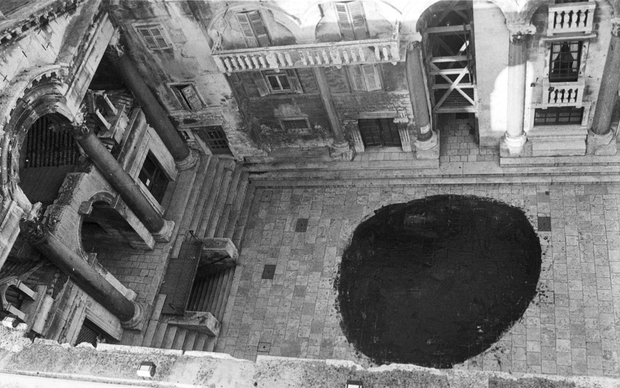 Igor Grubic, Black Peristil, 1998
Igor Grubic, Black Peristil, 1998
At the time, it wasn’t known who was responsible for the act, until Grubić went public months later as the author of the work that was meant to contrast ‘red history’ against ‘the dark present’.
The Peristil of Light was an ambient installation put up on two occasions, on Christmas 1991 and on Christmas 1997, by the painter Alieta Monas. It was a square of light that was placed on the northwest tower of Diocletian's Palace, together with a round piece of red cloth.
The legendary Red Peristil seems to have been a source of inspiration for many, including the artist Petar Grimani who marked the 40th anniversary of the controversial work by launching 40 flares in the main courtyard of Diocletian’s Palace. Named the Flying Peristil by the media, the action had the space lit red for a short period of time.
In 2009, Torcida staged a protest of their own, covering the square with an enormous yellow plastic bag inscribed with the word 'Kodeks' in blue, altogether reminiscent of shopping bags specific to the company Kerum.
The action was meant as a protest against ‘Kerumisation of Hajduk’, i.e. entrepreneur and then Mayor of Split Željko Kerum installing his acquaintances in high positions in Hajduk management.
Dubbed Yellow Peristil by the media, the intervention was condemned by the local authorities, with the mayor stating it wasn’t an art installation but a work of extremists helping the opposition to bring down the city leaders. Torcida in turn stated they were no one's puppet, but only wanted for the leading people of Hajduk to be selected on the basis of merit and expertise.
Next we have the Glass Peristil, a project that took place in the virtual world instead on the Split square. It was designed by art historian and artist Nikola Bojić, who in 2008 anonymously shared a project with the media, signed only as Majorian 458. It was an imaginary architectural project which envisaged construction of a commercial and residential building made of glass on the Peristil square, complete with helipads in the Vestibule and underground garages in the Diocletian’s Cellars, were connected to the Peristyle by escalators.
Even though the project obviously wasn't real and was meant to start a discussion about the need of putting culture before profit when designing public spaces, sensationalist headlines sent the public into a frenzy, and the work was called a ‘terrorist attack on public space, cultural monuments and the historic urban environment’.
And finally, we're back where we started, with gold being the latest colour to adorn the Peristil Square.
Vlaho Bukovac in Zagreb: Exhibition Dedicated to Croatian Art Icon to Open in February
February 6th, 2022 - The Klovićevi Dvori Gallery announced the second exhibition in the series dedicated to Croatian artist Vlaho Bukovac. It covers the period after Bukovac returned to Zagreb, where he created some of his best known masterpieces and influenced a whole new generation of artists
There are some artists whose work you’ll go and fawn over no matter how many times you’ve seen it in the past. One such artist is Vlaho Bukovac, a superb Croatian painter who created his best work at the turn of the 20th century.
In 2018, the Klovićevi Dvori gallery in Zagreb launched the ambitious project ‘Vlaho Bukovac in Europe’, an exhibition series dedicated to the great artist, split into several distinctive stages of his life and work.
The first exhibition in the series, titled Vlaho Bukovac in Paris, 1878-1892 and held in 2018, featured the early work of Bukovac, from his amateur beginnings in North America, art school in Paris, occasional work stays in England, as well as short but fruitful stays in the homeland, until he finally returned home for a longer period of time.
The gallery in Zagreb has now announced the second exhibition in the series, titled Roots and Wings: Vlaho Bukovac in Zagreb, Cavtat and Vienna, 1893-1903. The long-awaited exhibition is opening in February 2022 and will thus also mark the hundredth anniversary of Bukovac's death.
The exhibition is covering the period after Bukovac returned to Zagreb, where he soon became a central figure of the cultural scene and a great mentor to the young generation of artists. His seductive colorism influenced a whole new generation of painters in Zagreb, so much so they became known as the Zagreb School of Colour.
Owing to Bukovac, Zagreb became the region’s leading hotspot for artistic events. It was also the period when the artist was most prolific in terms of his work, as it was Zagreb where, driven by creative enthusiasm, he created some of his best known masterpieces.
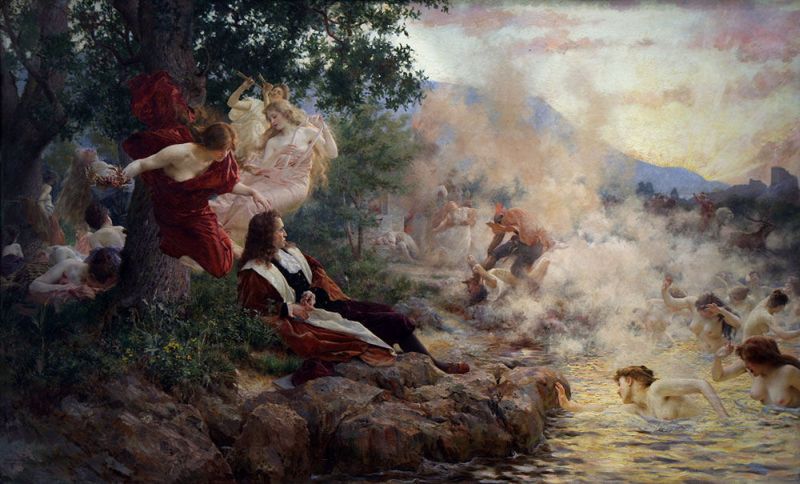 Vlaho Bukovac, Gundulic's Dream (1894)
Vlaho Bukovac, Gundulic's Dream (1894)
As a prominent figure on the social scene in Zagreb who often socialised with the intellectual elite, Bukovac portrayed members of distinguished families such as the Vranyczany, Pongrač, Nossan, Miletić, Farkaš, Crnadak and Berger.
The exhibition will also feature an opus created in his native Cavtat between 1899 and 1902. In terms of style, Bukovac reached his creative peak in his hometown, creating some of the most beautiful works of plein-air painting.
He stayed in Cavtat for four years, and later moved to Vienna with his family. His stay in Vienna and the success of his solo exhibition will be crucial for his later move to Prague.
The exhibition will present the life and work of Bukovac in chronological order, providing an in-depth look into numerous events in his life and the role they played in his work.
The works for the exhibition were borrowed from numerous museums and galleries in Croatia and neighbouring countries. We’ll have an opportunity to see paintings that were thus far completely unknown to the public, on loan by private collectors.
Authors of the exhibition: Petra Vugrinec and Lucija Vuković
Co-authors: Iskra Iveljić, Irena Kraševac, Dragan Damjanović i Petar Petrović
Curator: Iva Sudec Andreis
Klovićevi dvori gallery, Zagreb
February 18th - May 22nd, 2022
Unknown Klimt: Works of Legendary Artist on Display in Rijeka After 136 Years
Early in his career, Gustav Klimt was commissioned to create three ceiling paintings for the new theatre building in Rijeka. It took 136 years for the public to finally get to see them up close. The exhibition Unknown Klimt: Love, death, ecstasy at the Rijeka City Museum provides a rare chance to discover the early works of the legendary artist
Gustav Klimt is undoubtedly one of the most famous artists of all time. Did you know that three of his works have been created specifically to be displayed in Rijeka, Croatia? Not in a museum (not until recently, at least), but mounted on the ceiling of the Croatian National Theatre Ivan Zajc, along with six other works painted by Klimt’s brother Ernst and another Viennese artist, Franz Matsch.
The theatre building in Rijeka was designed by the renowned Viennese architectural studio Helmer and Fellner, specialised for theatres and concert halls. Dozens of cultural landmarks were built after their plans across central Europe in the second half of the 19th century, including the Croatian National Theatre buildings in Zagreb and Varaždin. Out of their three theatre projects in Croatia, the one in Rijeka has the best preserved original form; it was also the first building in Rijeka to get electrical lighting and was equipped with the first telephone in town.
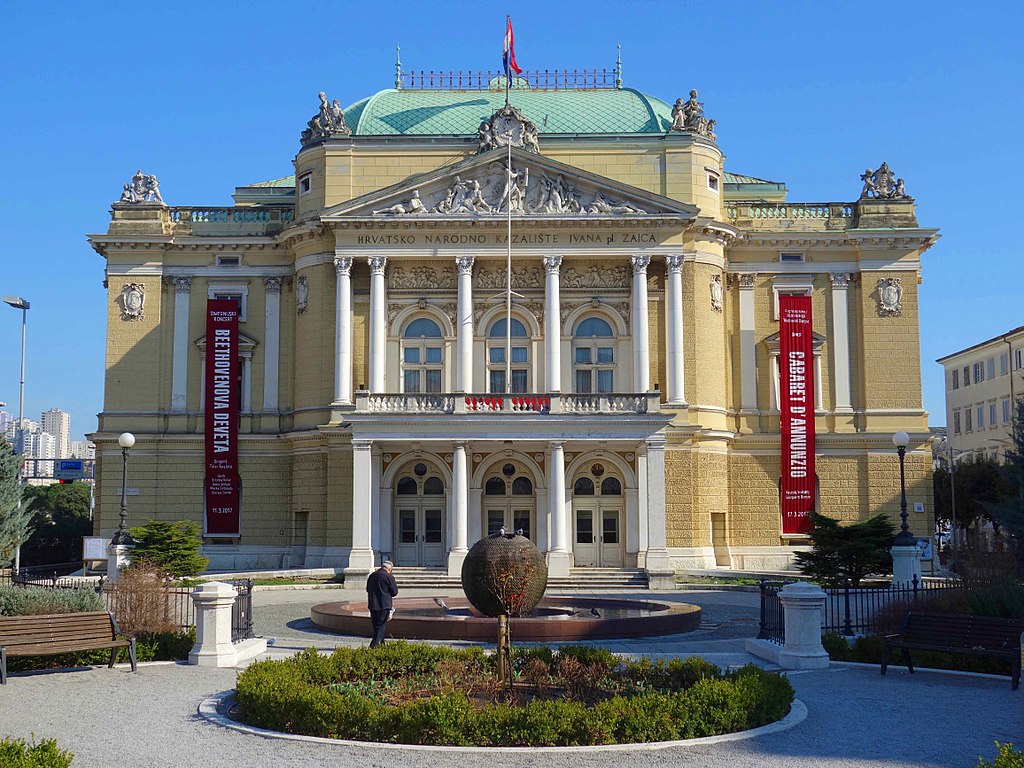
The Croatian National Theatre in Rijeka / Image by Antonio199Cro, Wiki Commons
In 1885, the architects commissioned artworks for the interior from three young Viennese artists who worked together under the name of Art Society (Die Künstler-Compagnie): brothers Gustav and Ernst Klimt, and Franz Matsch. They were all just getting their careers off the ground; Gustav, who would later become the biggest name of the three, was only 23 years old at the time.
The artists were to produce nine large format paintings depicting mythical and historical scenes, widely popular at the time and also thematically suitable for theatre decor. The completed commissioned works were shipped to Rijeka and installed on the ceiling of the auditorium in the new theatre.
All three artists went their separate ways in years following the Rijeka commission. Ernst Klimt died young, in 1892, and was thus deprived of the chance to achieve notable artistic renown. His death also marked the end of the Art Society, as the other two artists decided to part ways and explore different artistic avenues.
Gustav Klimt embraced the groundbreaking Art Nouveau style and eventually became the icon of the revolutionary movement, while Matsch chose the familiarity of the traditional academic milieu, going on to work as a portraitist in the aristocratic circles.
The nine large canvases painted for the theatre in Rijeka provide valuable insight into the early stages of the artists’ careers, especially Gustav Klimt who would in time develop a particularly distinctive style not at all reminiscent of the classical theatrical decor.
A once in a lifetime opportunity
In March and April 1885, right after the three artists completed the commission, the paintings were displayed in the Museum of Art and Industry in Vienna before they were shipped to Rijeka.
In 136 years since the works were painted, this was the single time they were displayed at ground level, in a museum environment where they could be admired by the public.
As soon as they arrived in Rijeka, they were mounted on the ceiling of the auditorium in the new theatre and remained at a height of some 20 metres above ground for over a century. While technically visible from the auditorium, one would have to strain their neck significantly trying to make out the main motifs of the paintings; they fit superbly into the grandeur of the ornate theatrical decor, but it’s not the optimal way to appreciate the likes of Klimt.
The paintings were restored once before as part of a larger scale renovation of the theatre building in 1978, but were not displayed publicly at the time.
And then came 2020 and a grand exhibition at the Sugar Palace of the Rijeka City Museum. Unknown Klimt: Love, death, ecstasy literally provides a once in a lifetime opportunity to see the precious works up close and admire the intricate details.

Ernst Klimt, Genius With a Trumpet
In the preparatory stages of the exhibition planning, the nine paintings were dismantled from the theatre ceiling in 2018 and have undergone a thorough restoration. Works by Gustav Klimt and Matsch were restored by Ana Rušin Bulić and Goran Bulić at the Rijeka department of the Croatian Restoration Institute, while those created by Ernst Klimt were shipped to the Easel Painting Department of the Croatian Restoration Institute in Zagreb where Slobodan Radić performed restorative works.
Once the exhibition closes and the canvases are installed back on the theatre ceiling where they belong, we’re unlikely to get another chance to admire them up close in our lifetime. Unknown Klimt was originally supposed to close in late 2021, but due to popular demand the exhibition was extended and will remain open until March 31st, 2022.
If the road takes you to Rijeka - the upcoming carnival in February could be a nice motivator to visit - we urge you to stop by the Sugar Refinery Palace and avail of this rare opportunity to see the early works of the world famous master and his fellow artists.
Make sure to also check out the superb permanent exhibit at the Rijeka City Museum at the same location; it’s a must-see spot in Rijeka and is included in the ticket for the Klimt exhibition.
The following nine works made for the Rijeka theatre are displayed at the exhibition Unknown Klimt:
Gustav Klimt:
St. Cecilia
Anthony and Cleopatra
Orpheus and Eurydice
Ernst Klimt:
Allegory of Theatrical Art
Genius with a trumpet
Genius with a basket of flowers
Franz Matsch:
Allegory of Love Poetry
Allegory of Dance
Allegory of Comic Opera
Learn more about the exhibition at the Rijeka City Museum website.
Picasso and Miro Exhibition to Be Held in Opatija This Summer
ZAGREB, 9 May 2021 - The original works of Pablo Picasso and Joan Miro will be exhibited this summer in the Juraj Šporer Art Pavillion in Opatija, a press conference heard last Wednesday.
The exhibition opens on 2 June and will last until 10 October 2021, the director of the Opatija Festival, Ernie Gigante Dešković, said. A part of the exhibition is dedicated to Picasso and the other to Miro, under the common title "Friendship, Freedom", said Gigante Drašković.
"A few years ago we brought back the performances of great international music stars to the Summer Stage. Thus the Summer Stage again became one of Croatia's most important music locations. Now we have decided to do the same with the Juraj Šporer Art Pavillion", he said.
Those behind the Opatija Festival have decided to turn that exhibition area into one of the most important locations in Croatia, where it will be possible to see attractive international exhibitions.
In order to meet the high standards and conditions required by this exhibition, the gallery space is being remodeled and special security measures are being introduced.
As a co-organizer of the exhibition, the director of IPL Art, Iva Piglić Lazić, said that the preparation had been underway for seven months now. The works that will be on display are part of private collections and could not be seen in Croatia by now, she said.
Of the 140 works available, we will exhibit most of them, Piglić Lazić said. She especially thanked the Opatija Tourist Board and the City of Opatija, who had recognized the project, for cooperation, as well as other associates and sponsors.
For more travel information about Opatija, be sure to visit Total Croatia's guide HERE.
For more about lifestyle in Croatia, follow TCN's dedicated page.
Touch of Baranja Photo Exhibition in Zagreb Until End of April
April 21, 2021 - A Touch of Baranja showcases 20 photos of the Baranja region to promote this rich natural and cultural site to both domestic and foreign visitors.
If you want to experience a touch of Baranja, but you're stuck in Zagreb, the city's Flower square (Cvjetni trg) offers you a compromise.
Dodir baRAnJe (A Touch of Baranja), an outdoor photo exhibition that will remain open until the end of April, highlights 20 photos of beautiful Baranja.
''A picture says a thousand words, so this is how we decided to present the beauty of Baranja and motivate Zagreb's citizens and their guests to visit the region located between the Danube and Drava rivers next to the border with Hungary to have a proper break,'' says the website of the Baranja Tourist Board.
The Tourist Board, along with Tourist Boards of Draž and Bilje-Kopački Rit hosted the event.
Nenad Milić, Dubravko Franjin, Romulić&Stojčić Studio, Mario Đurkić, and Zvonimir Janković are the photographers whose work is being featured in the exhibition. Below every photo, there is a QR code that offers an explanation of the photo both in English and Croatian, and in the evening, the photos are illuminated by solar power collected during the day.
As written by the Explore Croatia site, Baranja is special for its display of multiculturalism of the people who live there and who have previously passed through the territory. Tradition and cultural heritage in the area have survived the challenges of time, and nowhere is that more visible than in Baranja's cuisine.
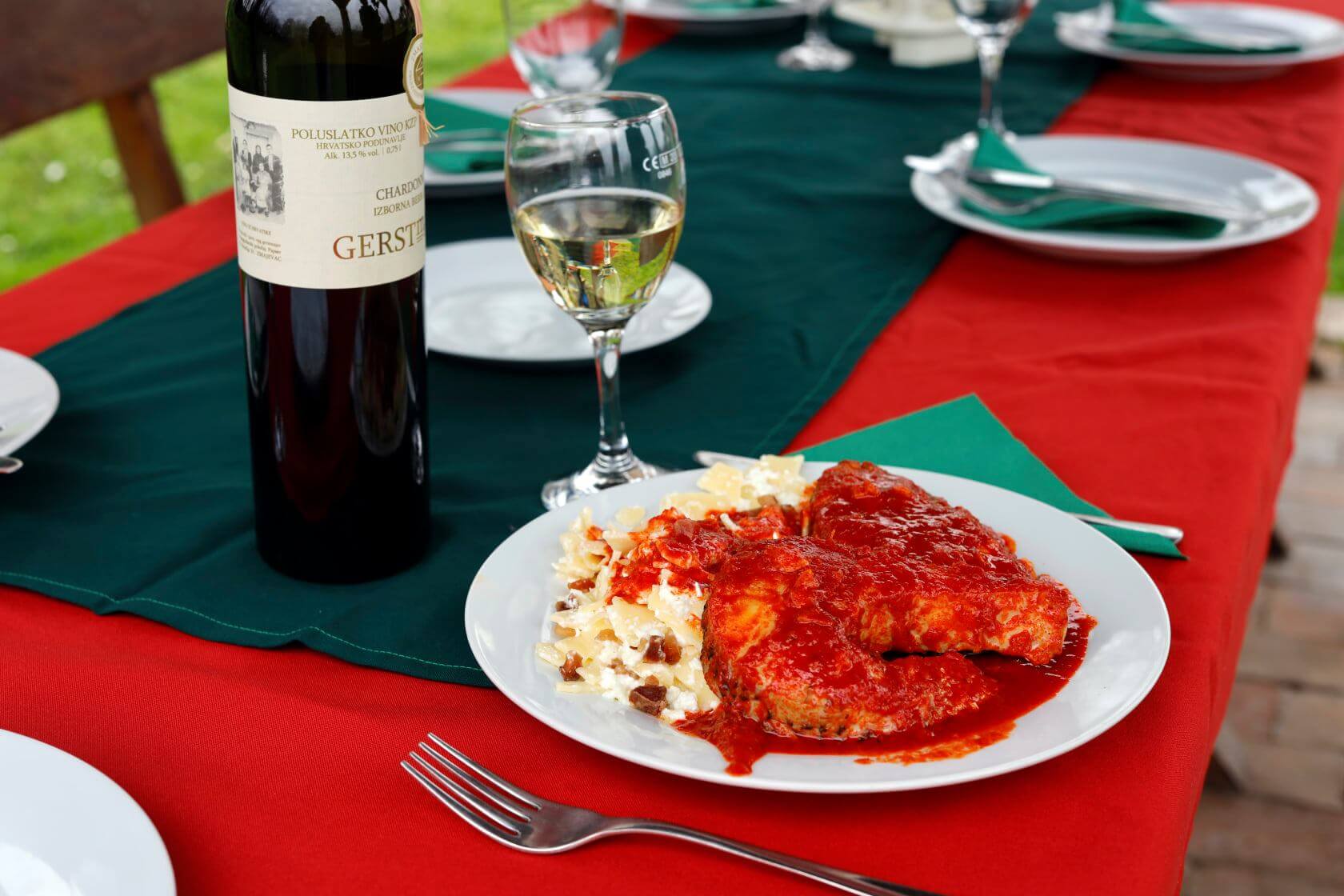
© Visit Baranja
''Baranja continues to remain a special destination which will tell the traveller various stories about tradition, family, life secrets, love, death, wines, hot peppers, specific fishing, weddings…“, explains the Explore Croatia site.
Baranja also offers the richness of nature as it is surrounded by rivers and the Kopački Rit swamp and bird reserve that is home to a wide and impressive variety of animals and plants, representing a real treat for the dedicated traveller.
When in Baranja, make sure to try the delicious Fiš Paprikaš, Baranja's own local Kulen recipe, and carp prepared in a delicious way only Baranja knows how to do.
Learn more about Croatia's food on our TC page.
For more about travel in Croatia, follow TCN's dedicated page.
VukovART 2021 to Return Art, Culture and Joy to the City of Vukovar
April 20, 2021 - With a five-year tradition already in place, VukovART 2021 promises a month of fun and exciting activities for Vukovar with visual eye candy as souvenirs to last.
A unique concept in the culture and art of Vukovar, the VukovART festival will be held from May 15 all the way to June 15, writes HRTurizam.
With a five-year tradition, the streets and squares of Vukovar will once again host numerous exhibitions and workshops, debates, children's programs, film, and literary programs, panel discussions, colorful lectures, and concerts. This event, organized by the City of Vukovar and Val Kulture association, co-financed by the European Social fund, promotes Vukovar as a Port of Art, changing the visual identity of the city making it a beautiful place to live. In addition to the local community, tourists also enjoy the eye candy of the city's open-air gallery. Artists Boa Mistura (Spain), BustArt (Switzerland), Jana Brike (Latvia), Mr Woodland (Germany), Victor Splash (Russia), Artez (Serbia), Juandres Vera (Mexico), Kerim Musanović (Bosnia and Herzegovina), Marion Ruthardt from (Germany), and Croatia's own Forest are ten artists who will come this year to give their contribution to the growing visual content of the city.
The festival will be opened by a beloved Croatian band Vatra (Fire), with performances of Mia Dimšić, musical composition CLUE, and vocal composition Watercolor in the following days too. During every larger event of the festival, „a superb craft scene and street food“ offers will be offered to visitors too.
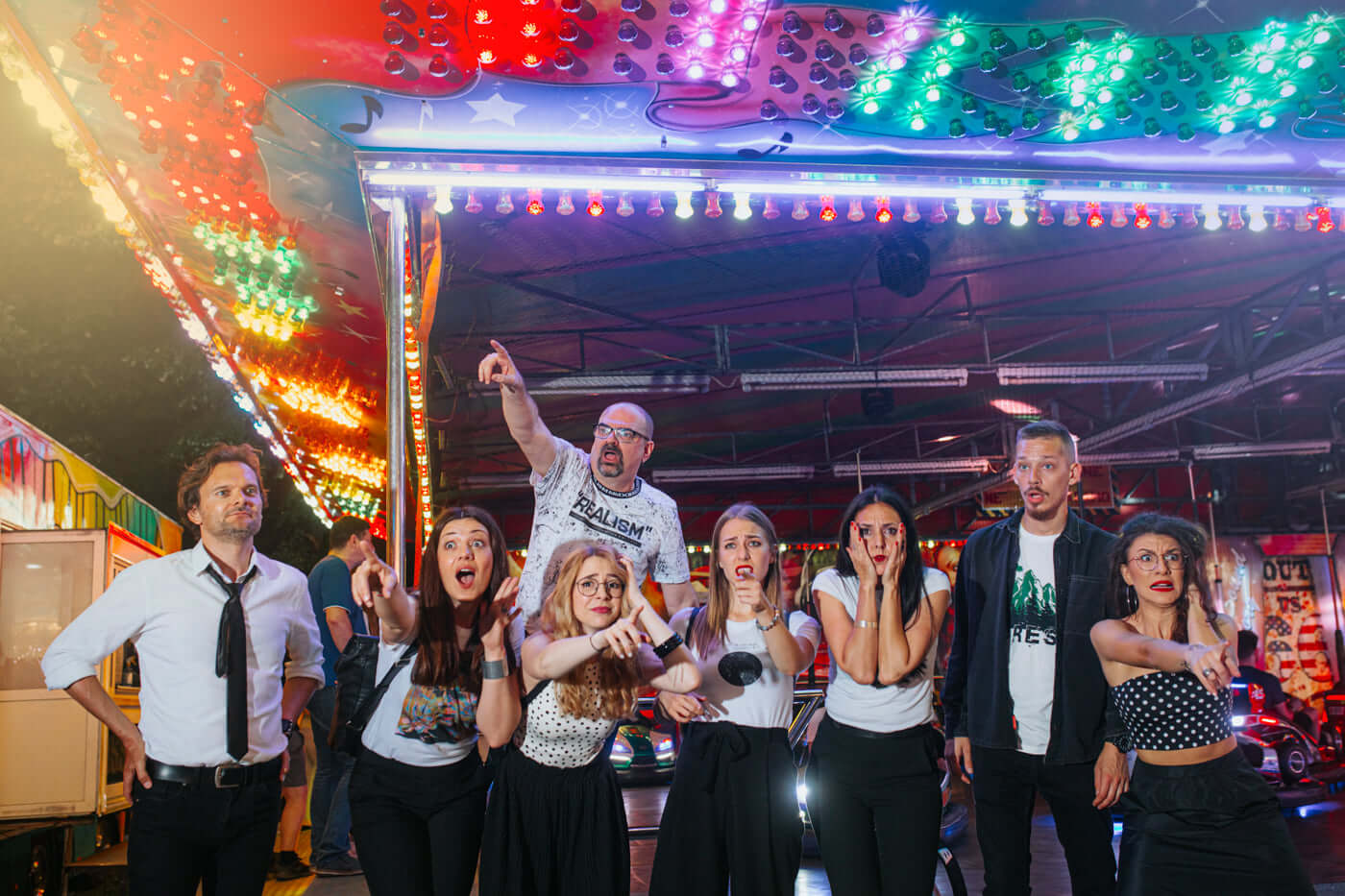
© VukovArt - Art Harbour
Famous Croatian singer from Psihomodo Pop with a neck in painting as well, Davor Gobac will exhibit his paintings and also host Motivational and Art Workshop for children.
„There will also be an active weekend led by the Vukovar Half Marathon, and for a slightly more relaxing activity, a bicycle race will be organized to tour previous works of art“, says HRTurizam article.
Domagoj Jakopović Ribafish, Dusan Bučan, and Robert Knjaz will host travel lectures and the full program and more details can be found on VukovART official website and on social networks.
Learn more about Croatia's festivals on our TC page.
For more about Made in Croatia, follow TCN's dedicated page.
Zagreb Lauba's Revolutionary Redesign by World-Famous Japanese Architect
ZAGREB December 13, 2020 – .One of Croatia's best-loved gallery and event spaces will undergo a revolutionary new facelift at the hands of a world-famous architect. Zagreb Lauba's new look comes at the hands of internationally acclaimed Sou Fujimoto. A serial award winner, the architect's prominent works are found all over the world.
Newly-released images of how Zagreb's Lauba will look show an incredibly imaginative redesign. Echoing the avenue of trees that runs by the side of the gallery and event space, Sou Fujimoto has planned an oval-shaped garden roof space for the building in which trees will also be planted. The inspiration for the design came from Zagreb Lauba's name – it is a colloquial word used to describe a certain circular area of trees, the architect being informed of this by gallery owner Tomislav Klitschko.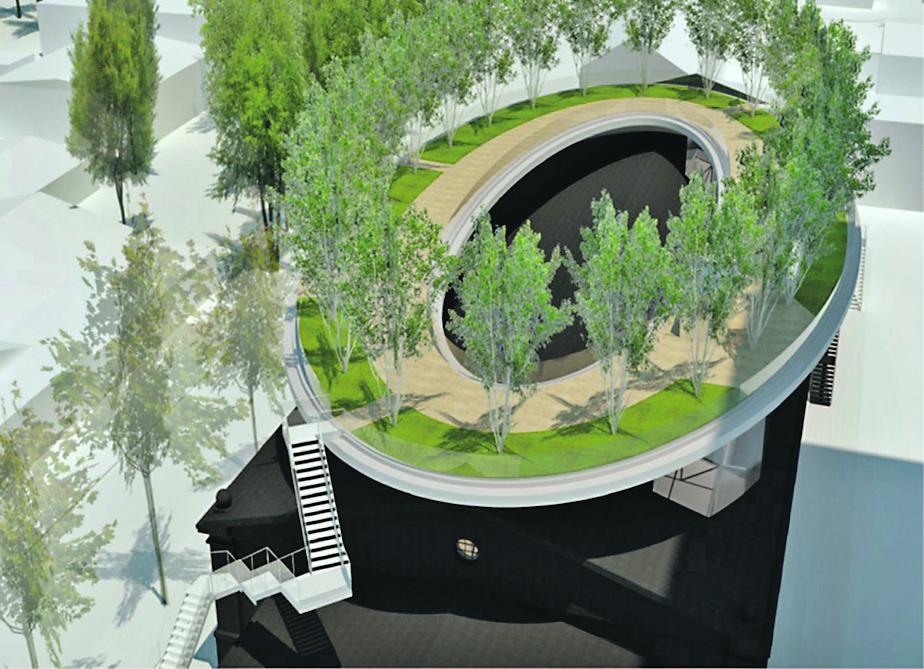 © Sou Fujimoto Architects / Lauba
© Sou Fujimoto Architects / Lauba
According to Jutarnji List's coverage of the redesign, by journalist Patricia Kish, the new roof garden space will be accessed by stairs and lift. Zagreb Lauba's design as it stands today was originally made by Alenka Gačić-Pojatina, who will collaborate on the new additions by Sou Fujimoto.
Zagreb Lauba's story dates back to 1910 when it was constructed by Emil Eisner and Adolf Ehrlich for use as a stables and riding school for the Austro-Hungarian army. It later became the weaving mill of the Textile Combine Zagreb, which it remained until being converted to a gallery and event space in 2008.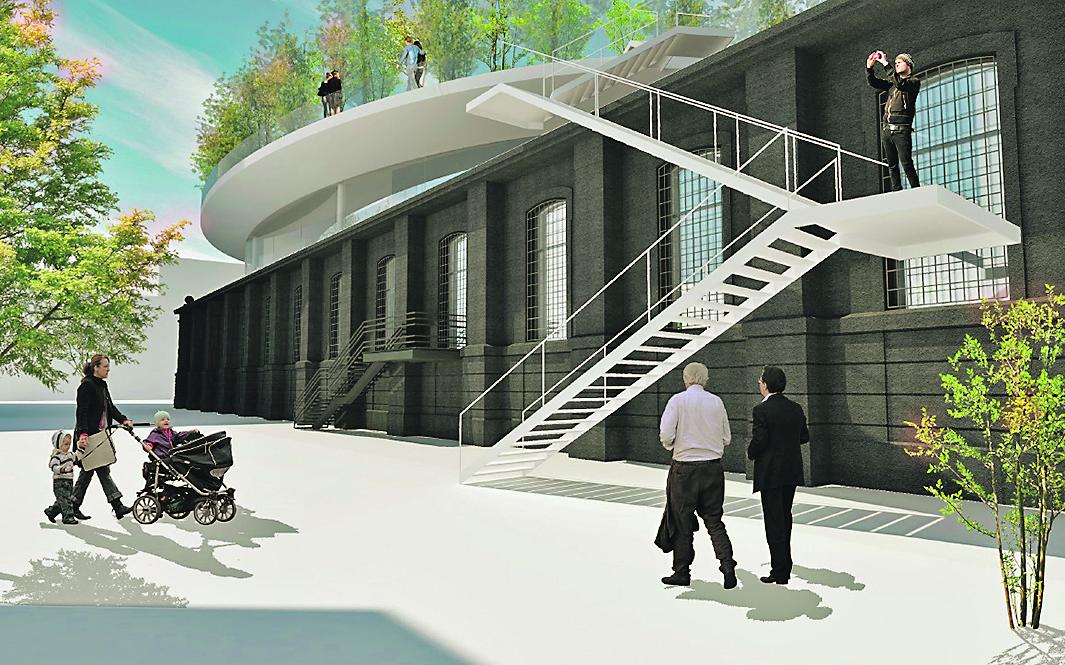 © Sou Fujimoto Architects / Lauba
© Sou Fujimoto Architects / Lauba
Sou Fujimoto is one of the most celebrated architects of Japan. He has won several prestigious awards for his work and the acclaim has made his designs much in-demand around the world. Often working with wood and natural materials, his designs can be found in London, Paris, Budapest and soon, at Zagreb Lauba's hands, in Croatia.
Lauba is a contemporary art gallery and its mission is to discover artistic expression by Croatian visual artists, and also participate in international cultural trends. Set in a huge black building near Črnomerec its exhibitions usually change around every month. In recent times it has also played host to large-scale electronic music events.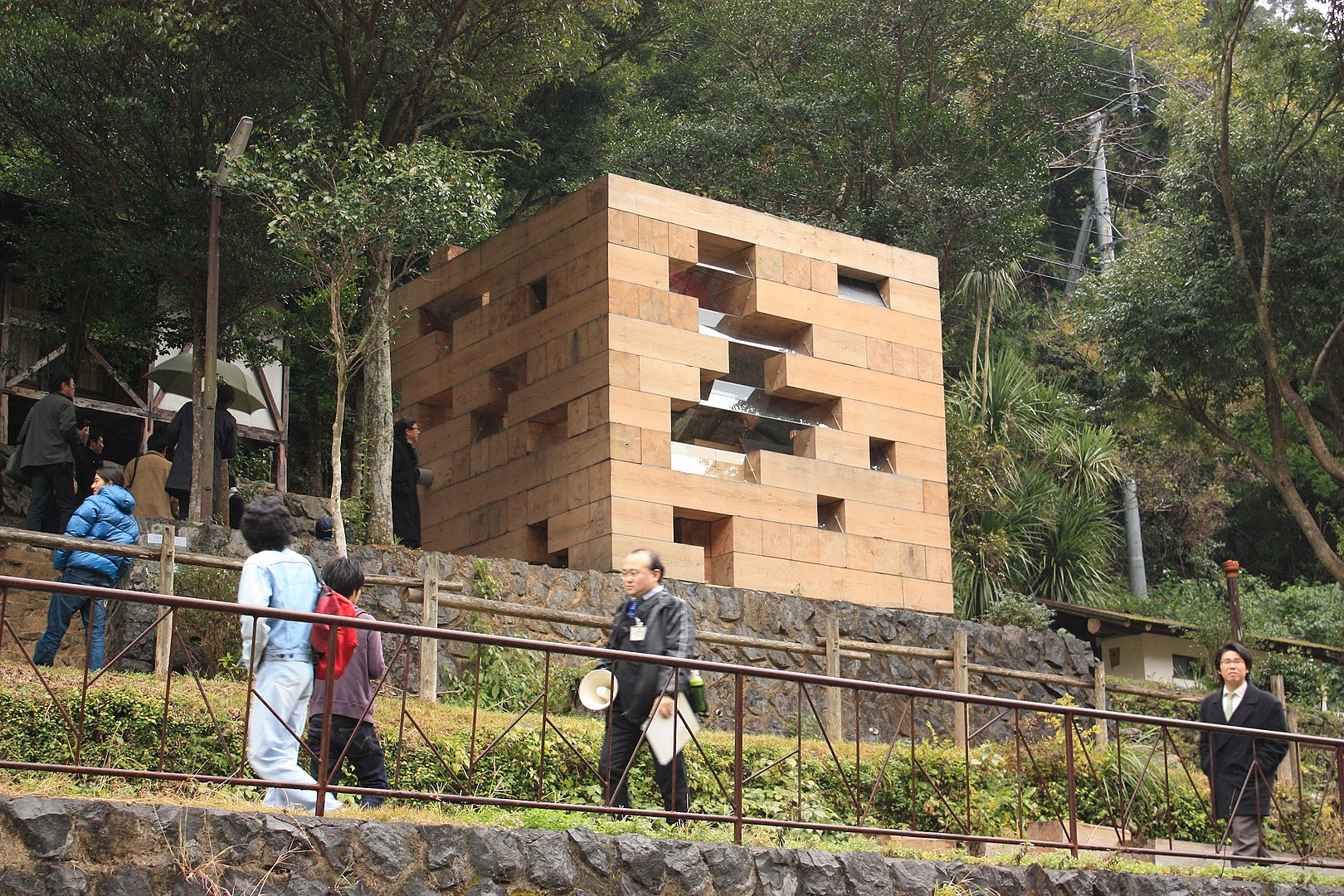 One of Sou Fujimoto's previous designs © Kenta Mabuchi
One of Sou Fujimoto's previous designs © Kenta Mabuchi
Meet Kristina Marić, a Multimedia Artist from Đakovo
Kristina Marić is a multimedia artist that was born in Đakovo in 1990. She graduated from the Art Academy in Osijek in the Department of Fine Arts and Multimedia in 2015. In 2013, Marić had a residence at the Art Quarter Budapest. She is the recipient of the Red Carpet Art Award for young artists in 2017. In 2018, she was a finalist for the Radoslav Putar Award from the Institute for Contemporary Art in Zagreb. Marić is a member of the Croatian Society of Fine Artists Osijek and is actively exhibiting at exhibitions and festivals in Croatia and abroad. Since 2016, she has worked as an assistant at the Academy of Arts and Culture in Osijek.


